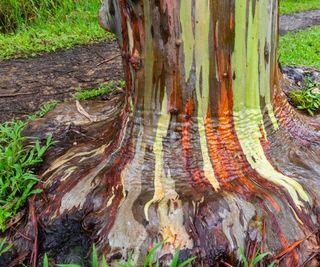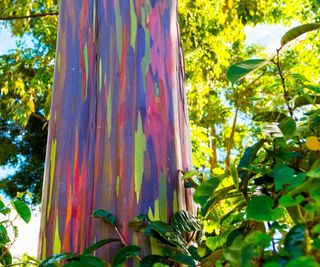It is amazing, when you think of it, that we use one word, tree, to describe over 70,000 different arboreal species that grow in the far corners of the Earth. While all trees have an elongated trunk reaching upwards, typically supporting a canopy or canopies of leaves, within this vague description there is much diversity.
Trees are found on every continent, except for Antarctica, growing in unique environments requiring each species to develop unique adaptations over thousands and millions of years. Trees are so much more than the sum of their parts, and what we see today is the product of the ingenuity of the natural world.
Here, Homes and Gardens Content Editor, Thomas Rutter, discusses an unusual, otherworldly eucalyptus species with rainbow-colored bark.
The Kaleidoscopic Rainbow Tree

(Image credit: Alamy/Westend61 GmbH )
It might sound fanciful, but there is such a thing as a multicoloured tree. Eucalyptus deglupta, commonly referred to as the rainbow eucalyptus, grows in tropical rainforests within equatorial regions of the Philippines, Indonesia and Papua New Guinea, and is the only species of eucalyptus that’s native to both the northern and southern hemispheres.
Unsurprisingly, the rainbow tree was named for its multicoloured appearance, which seems almost unreal on first inspection. Its kaleidoscopic trunk and limbs appear painted in a variegated display of browns, purples, oranges, greens and yellows. The bark sheds in thin layers, revealing a neon-green layer beneath, and as it ages and weathers, different pigments are produced, resulting in the distinctive spectrum of colours. It is supposed that these pigments help to shield the inner layers from excessive sunlight and UV radiation, which can cause damage to the tree’s tissues, particularly in the tropics. The patterns that form on the surface of the trunk appear to be almost brush-like, as if an artist of some abstract persuasion was seeking to create something surreal. Over time, the bark will gradually return to a brown colour, and at this stage, the shedding process is almost ready to begin once again.
While the rainbow eucalyptus has now been grown and planted in different countries across the world, its kaleidoscopic colouring is best seen where the tree thrives in its native tropical climate, where ideal growing conditions contribute to rapid growth and intensify the rainbow display.
How to see rainbow trees

(Image credit: Alamy/Gerold Grotelueschen)
Imagine an Impressionist painting manifested as a tree. That’s E deglupta, more commonly known as the rainbow eucalyptus. The only eucalypt evolved to thrive in a rainforest habitat, this striking tree has a limited natural range, restricted to Papua New Guinea and areas of the Philippines and Indonesia, but its multicoloured bark makes it a favourite of botanical gardens worldwide.
Finding rainbow trees in the wild requires a little effort. In Papua New Guinea, the trees grow from close to sea level up to 8200ft (2500m), but there are no trails dedicated specifically to spotting this colourful species, so you’ll have to keep your eyes peeled on rainforest hikes. Try your luck on trails at lower elevations, such as the challenging Kapa Kapa Trail from Gabagaba village on the island’s southern coast.
Although not native to the Pacific islands, rainbow trees are arguably easier to see in the well-maintained botanical gardens of Hawaii – there are some much-photographed rainbow gums on the 1-mile (1.6km) Ke’anae Arboretum Trail in the Ke’anae Arboretum on Maui, while the Keahua Arboretum on Kaua‘i has the short Rainbow Eucalyptus trail, passing some colourful mature specimens.
FAQs
Can I grow a rainbow eucalyptus at home?
Rainbow eucalyptus trees are certainly statement trees, with remarkable colored bark as discussed here. Native to equatorial climates, this tree needs warmth, sunshine and humidity to grow well, such as the conditions found in US hardiness zone 10 in states such as Hawaii, California, Texas and Florida. Most experts agree that the coloring is best seen in rainforest-like environments, where the tree can grow up to 250 feet tall. So, while you can grow a smaller specimen in your yard, it might be best to plan a trip to the tropics and enjoy this otherwordly tree species in its natural habitat.
Reproduced with permission from Lonely Planet © 2022.
The Tree Atlas by Matt Collins and Thomas Rutter, published by Lonely Planet, October 2024.
The Tree Atlas is available to order from Amazon.
The diversity of trees is truly remarkable, considering that the single word “tree” encompasses over 70,000 different species found around the world. Each tree, with its elongated trunk and leafy canopy, has evolved unique adaptations over thousands and millions of years to thrive in its specific environment. The rainbow eucalyptus, also known as Eucalyptus deglupta, is a prime example of this diversity, with its kaleidoscopic trunk displaying a mesmerizing array of colors. Native to tropical rainforests in the Philippines, Indonesia, and Papua New Guinea, this unique tree sheds its bark to reveal neon-green layers beneath, creating a stunning visual display. While the rainbow eucalyptus can now be found in various countries, its true beauty is best appreciated in its native tropical habitat. If you’re interested in seeing these colorful trees in person, botanical gardens in Hawaii offer a perfect opportunity to witness this natural wonder up close. While growing a rainbow eucalyptus at home may be challenging due to its specific climate requirements, experiencing this otherworldly tree species in its natural environment is truly a sight to behold.
